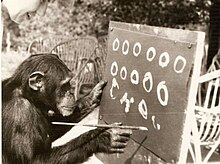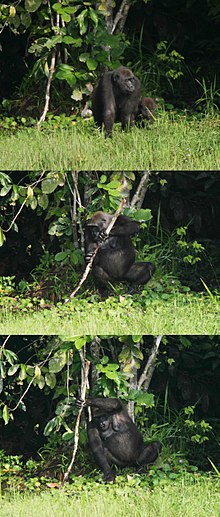Primate cognition
This article needs additional citations for verification. (March 2012) |


Primate cognition is the study of the intellectual and behavioral skills of non-human
Primates are capable of high levels of cognition; some make tools and use them to acquire foods and for social displays;
Studies in primate cognition
Theory of Mind
Theory of mind (also known as mental state attribution, mentalizing, or mindreading) can be defined as the "ability to track the unobservable mental states, like desires and beliefs, that guide others' actions".
Non-human research still has a major place in this field, however, and is especially useful in illuminating which nonverbal behaviors signify components of theory of mind, and in pointing to possible stepping points in the evolution of what many claim to be a uniquely human aspect of social cognition.[13][14][15] While it is difficult to study human-like theory of mind and mental states in species which we do not yet describe as "minded" at all, and about whose potential mental states we have an incomplete understanding, researchers can focus on simpler components of more complex capabilities.
For example, many researchers focus on animals' understanding of intention, gaze, perspective, or knowledge (or rather, what another being has seen). Part of the difficulty in this line of research is that observed phenomena can often be explained as simple stimulus-response learning, since mental states can often be inferred based on observed behavioural cues.
Attribution of Intentions
Research on chimpanzees, capuchin monkeys, and Tonkean macaques (Macaca tokeana) has provided evidence that they are sensitive to the goals and intentions of others and are able to differentiate between when an experimenter is unable to give them food versus when the experimenter is just unwilling to.[16][17]
Attribution of Knowledge (and Perception)
Hare et al. (2001) demonstrates that chimpanzees are aware of what other individuals know. They can also understand what another perceives, and they selectively choose food that is not visible to their competitor.[18]
Attribution of Belief
A false-belief test is a comprehensive test used to test for an individual's theory of mind. Understanding language is a key component to being able to understand the directions for the false-belief test, and researchers have had to get creative to utilize this test in the research of non-human primates' theory of mind. Recent technology has enabled researchers to closely resemble the false-belief task without needing to use language. In Krupenye et al. (2016), an advanced eye-tracking technology was used to test for false-belief understanding in apes. The findings of this experiment showed that apes understood and accurately anticipated the behavior of an individual who held a false belief.[19]
There has been some controversy over the interpretation of evidence purporting to show theory of mind ability—or inability—in animals. Part of this debate has involved whether animals are really able to associate cognitive abilities with another individual, or if they are just able to read and understand behavior.[20][21] Povinelli et al. (1990) points out that most evidence in support of great ape theory of mind involves naturalistic settings to which the apes have already adapted through past learning. Their "reinterpretation hypothesis" explains away evidence supporting attribution of mental states to others in chimpanzees as merely evidence of risk-based learning; that is, the chimpanzees learn through experience that certain behaviors in other chimpanzees have a probability of leading to certain responses, without necessarily attributing knowledge or other intentional states to those other chimpanzees. They have proposed testing theory of mind abilities in great apes in novel, and not naturalistic settings.[22] Experimenters since then, such as demonstrated in Krupenye et al. (2016), have gone to extensive lengths to control for behavioral cues by placing the apes in novel settings as suggested by Povinelli and colleagues. Research has shown that there is substantial evidence for some non-human primates to track the mental state, like desires and beliefs, of other individuals that cannot be deduced to a response of learned behavioural cues.[19]
Communication in the wild
For most of the 20th century, scientists who studied primates thought of vocalizations as physical responses to emotions and external stimuli.[23] The first observations of primate vocalizations representing and referring to events in the exterior world were observed in vervet monkeys in 1967.[24] Calls with specific intent, such as alarm calls or mating calls has been observed in many orders of animals, including primates. Researchers began to study vervet monkey vocalizations in more depth as a result of this finding. In the seminal study on vervet monkeys, researchers played recordings of three different types of vocalizations they use as alarm calls for leopards, eagles, and pythons. Vervet monkeys in this study responded to each call accordingly: going up trees for leopard calls, searching for predators in the sky for eagle calls, and looking down for snake calls.[25] This indicated a clear communication that there is a predator nearby and what kind of predator it is, eliciting a specific response. The use of recorded sounds, as opposed to observations in the wild, gave researchers insight into the fact that these calls contain meaning about the external world.[26] This study also produced evidence that suggests vervet monkeys improve in their ability to classify different predators and produce alarm calls for each predator as they get older. Further research into this phenomenon has discovered that infant vervet monkeys produce alarm calls for a wider variety of species than adults. Adults only use alarm calls for leopards, eagles, and pythons while infants produce alarm calls for land mammals, birds, and snakes respectively. Data suggests that infants learn how to use and respond to alarm calls by watching their parents.[27]
A different species of monkeys, the wild Campbell's monkeys have also been known to produce a sequence of vocalization that require a specific order to elicit a specific behaviour in other monkeys. Changing the order of the sounds changes the resulting behaviour, or meaning, of the call. Diana monkeys were studied in a habituation-dishabituation experiment that demonstrated the ability to attend to the semantic content of calls rather than simply to acoustic nature. Primates have also been observed responding to alarm calls of other species. Crested Guinea fowl, a ground-dwelling fowl, produce a single type of alarm call for all predators it detects. Diana monkeys have been observed to respond to the most likely reason for the call, typically a human or leopard, based on the situation and respond according to that. If they deem a leopard is the more likely predator in the vicinity they will produce their own leopard-specific alarm call but if they think it is a human, they will remain silent and hidden.
The ability for non-human primates to understand call systems that belong to a different species of monkey happens but to a limited extent. In this case Diana monkeys and Campbell's monkeys often form mixed species groups but they seem only to respond to each other's danger related calls.[28]
Tool use

There are many reports of primates making or using tools, both in the wild or when captive.
Tool making is much rarer, but has been documented in orangutans,
There is some more recent controversy over whether tool use represents a higher level of physical cognition, although this
Problem solving
In 1913, Wolfgang Köhler started writing a book on problem solving titled The Mentality of Apes (1917). In this research, Köhler observed the manner in which chimpanzees solve problems, such as that of retrieving bananas when positioned out of reach. He found that they stacked wooden crates to use as makeshift ladders in order to retrieve the food. If the bananas were placed on the ground outside of the cage, they used sticks to lengthen the reach of their arms.
Köhler concluded that the chimps had not arrived at these methods through
Asking questions and giving negative answers
In the 1970s and the 1980s there had been suggestions that apes are unable to ask questions and to give negative answers. According to numerous published studies, apes are able to answer human questions, and the vocabulary of the acculturated apes contains question words.[38][39][40][41][42] Despite these abilities, according to the published research literature, apes are not able to ask questions themselves, and in human-primate conversations, questions are asked by the humans only. Ann and David Premack's designed a potentially promising methodology to teach apes to ask questions in the 1970s: "In principle interrogation can be taught either by removing an element from a familiar situation in the animal's world or by removing the element from a language that maps the animal's world. It is probable that one can induce questions by purposefully removing key elements from a familiar situation. Suppose a chimpanzee received its daily ration of food at a specific time and place, and then one day the food was not there. A chimpanzee trained in the interrogative might inquire "Where is my food?" or, in Sarah's case, "My food is?" Sarah was never put in a situation that might induce such interrogation because for our purposes it was easier to teach Sarah to answer questions".[43]
A decade later Premacks wrote: "Though she [Sarah] understood the question, she did not herself ask any questions—unlike the child who asks interminable questions, such as What that? Who making noise? When Daddy come home? Me go Granny's house? Where puppy? Toy? Sarah never delayed the departure of her trainer after her lessons by asking where the trainer was going, when she was returning, or anything else".[44]
Despite all their achievements, Kanzi and Panbanisha also have not demonstrated the ability to ask questions so far. Joseph Jordania suggested that the ability to ask questions could be the crucial cognitive threshold between human and other ape mental abilities.[45] Jordania suggested that asking questions is not a matter of the ability to use syntactic structures, that it is primarily a matter of cognitive ability.
g factor of intelligence in primates
The general factor of intelligence, or
However, there is some debate as to the influence of g on all primates equally. A 2012 study identifying individual chimpanzees that consistently performed highly on cognitive tasks found clusters of abilities instead of a general factor of intelligence.[48] This study used individual-based data and claim that their results are not directly comparable to previous studies using group data that have found evidence for g. Further research is required to identify the exact nature of g in primates.
See also
- Animal cognition
- Cognitive tradeoff hypothesis
- Deep social mind
- Hominid intelligence
- Great ape language
- Primate empathy
- Primate archaeology
References
- ISBN 978-0-19-510624-4.
- PMID 2157651.
- PMID 9642788.
- S2CID 8190458.
- PMID 10739311.
- S2CID 4424086.
- S2CID 21042762.
- PMID 11459163.
- PMID 9642782.
- PMID 11561924.
- ^ S2CID 237857077.
- S2CID 141321709.
- S2CID 19504558.
- S2CID 143667510.
- S2CID 686663.
- PMID 15484596.
- PMID 28480137.
- S2CID 3402554.
- ^ S2CID 19959653.
- S2CID 37581900.
- PMID 17264056.
- PMID 2225758.
- ISBN 978-0-226-10244-3.
- S2CID 84150741.
- PMID 7433999.
- ^ "Robert Seyfarth: Can Monkeys Talk? - YouTube". www.youtube.com. Retrieved 2020-11-02.
- .
- PMID 10821618.
- ^ "Chimps craft ultimate fishing rod". Mar 3, 2009. Retrieved May 21, 2020 – via news.bbc.co.uk.
- ^ "'Armed' chimp gets honey reward". Mar 18, 2009. Retrieved May 21, 2020 – via news.bbc.co.uk.
- S2CID 27180148.
- S2CID 16551874.
- Amanda Pachniewska (November 2015). "Spear-Hunting Chimps". Animal Cognition.
- ^ "Chimps Use "Spears" to Hunt Mammals, Study Says". Science. Feb 27, 2007. Archived from the original on August 28, 2018. Retrieved May 21, 2020.
- ^ Vancatova, M. (2008). "Gorillas and Tools - Part I". Retrieved August 4, 2013.
- ^ Gill V (22 July 2011). "Mandrill monkey makes 'pedicuring' tool". BBC. Retrieved 11 August 2013.
- ^ "Mandrill using a tool to clean under its nails". Retrieved May 21, 2020.
- S2CID 18277620.
- ^ Terrace HS (1980). Nim. London: Eyre Methuen.
- ISBN 978-1-134-80514-3.
- ^ Premack D (1976). Language and intelligence in ape and man. Hillsdale, NJ: Lawrence Erlbaum Associates.
- ^ Rumbaugh DM, Gill TV (1977). "Use of 'Stock' sentences for other than the originally intended purpose.". In Rumbaugh DM (ed.). Language learning by a chimpanzee. The Lana project. New York: Academic Press. pp. 172–192.
- ^ Patterson F, Linden E (1981). The education of Koko. New York: Holt, Rinehart and Winston.
- .
- ^ Premack D, Premack AJ (1983). The mind of an ape. New York, London: W.W. Norton & Company. p. 29.
- Who Asked the First Question?The origins of human choral singing, intelligence, language and speech. Tbilisi, Georgia: Logos.
- ^ PMID 21357224.
- ^ Kamphaus RW (2005). Clinical assessment of child and adolescent intelligence. Springer Science & Business Media.
- PMID 22927574.
Further reading
- Gouteux S, Thinus-Blanc C, Vauclair J (2001). "Rhesus monkeys use geometric and nongeometric information during a reorientation task". Journal of Experimental Psychology: General. 130 (3): 505–519. PMID 11561924.
- Call J (June 2001). "Object permanence in orangutans (Pongo pygmaeus), chimpanzees (Pan troglodytes), and children (Homo sapiens)". Journal of Comparative Psychology. 115 (2): 159–171. PMID 11459163.
- de Blois ST, Novak MA, Bond M (June 1998). "Object permanence in orangutans (Pongo pygmaeus) and squirrel monkeys (Saimiri sciureus)". Journal of Comparative Psychology. 112 (2): 137–152. PMID 9642783.
- Neiworth JJ, Steinmark E, Basile BM, Wonders R, Steely F, DeHart C (March 2003). "A test of object permanence in a new-world monkey species, cotton top tamarins (Saguinus oedipus)". Animal Cognition. 6 (1): 27–37. S2CID 3070975.
- Westergaard GC, Lundquist AL, Haynie MK, Kuhn HE, Suomi SJ (June 1998). "Why some capuchin monkeys (Cebus apella) use probing tools (and others do not)". Journal of Comparative Psychology. 112 (2): 207–211. PMID 9642788.
- Brown DA, Boysen ST (December 2000). "Spontaneous discrimination of natural stimuli by chimpanzees (Pan troglodytes)". Journal of Comparative Psychology. 114 (4): 392–400. PMID 11149543.
- Neiworth JJ, Parsons RR, Hassett JM (April 2004). "A test of the generality of perceptually based categories found in infants: attentional differences toward natural kinds by New World monkeys". Developmental Science. 7 (2): 185–193. PMID 15320378.
- Parr LA, de Waal FB (June 1999). "Visual kin recognition in chimpanzees". Nature. 399 (6737): 647–648. S2CID 4424086.
- Fujita K, Watanabe K, Widarto TH, Suryobroto B (1997). "Discrimination of macaques by macaques: The case of sulawesi species". Primates. 38 (3): 233–245. S2CID 21042762.
- Parr LA, Winslow JT, Hopkins WD, de Waal FB (March 2000). "Recognizing facial cues: individual discrimination by chimpanzees (Pan troglodytes) and rhesus monkeys (Macaca mulatta)". Journal of Comparative Psychology. 114 (1): 47–60. PMID 10739311.
- Pascalis O, Bachevalier J (April 1998). "Face recognition in primates: a cross-species study". Behavioural Processes. 43 (1): 87–96. S2CID 16819043.
- Paar LA, Winslow JT, Hopkins WD (1999). "Is the inversion effect in rhesus monkeys face-specific?". Animal Cognition. 2 (3): 123–129. S2CID 18435189.
- Uller C, Hauser M, Carey S (September 2001). "Spontaneous representation of number in cotton-top tamarins (Saguinus oedipus)". Journal of Comparative Psychology. 115 (3): 248–257. PMID 11594494.
- Beran MJ (June 2001). "Summation and numerousness judgments of sequentially presented sets of items by chimpanzees (Pan troglodytes)". Journal of Comparative Psychology. 115 (2): 181–191. PMID 11459165.
- Hauser MD, Kralik J, Botto-Mahan C, Garrett M, Oser J (November 1995). "Self-recognition in primates: phylogeny and the salience of species-typical features". Proceedings of the National Academy of Sciences of the United States of America. 92 (23): 10811–10814. PMID 7479889.
- Heyes CM (1995). "Self-recognition in primates: Further reflections create a hall of mirrors". Animal Behaviour. 50 (6): 1533–1542. S2CID 20290540.
- Anderson JR (December 1997). "Self-recognition in Saguinus? A critical essay". Animal Behaviour. 54 (6): 1563–1567. S2CID 43373261.
- Hauser MD, Kralik J (December 1997). "Life beyond the mirror: a reply to Anderson & Gallup". Animal Behaviour. 54 (6): 1568–1571. S2CID 22836237.
- Neiworth JJ, Anders SL, Parsons RR (December 2001). "Tracking responses related to self-recognition: a frequency comparison of responses to mirrors, photographs, and videotapes by cotton top tamanins (Saguinus oedipus)". Journal of Comparative Psychology. 115 (4): 432–438. PMID 11824907.
- de Waal FB, Dindo M, Freeman CA, Hall MJ (August 2005). "The monkey in the mirror: hardly a stranger". Proceedings of the National Academy of Sciences of the United States of America. 102 (32): 11140–11147. PMID 16055557.
- Anderson JR, Mitchell RW (1999). "Macaques but not lemurs co-orient visually with humans". Folia Primatologica; International Journal of Primatology. 70 (1): 17–22. S2CID 46268265.
- Itakura S, Tanaka M (June 1998). "Use of experimenter-given cues during object-choice tasks by chimpanzees (Pan troglodytes), an orangutan (Pongo pygmaeus), and human infants (Homo sapiens)". Journal of Comparative Psychology. 112 (2): 119–126. PMID 9642782.
- Neiworth JJ, Burman MA, Basile BM, Lickteig MT (March 2002). "Use of experimenter-given cues in visual co-orienting and in an object-choice task by a new world monkey species, cotton top tamarins (Saguinus oedipus)". Journal of Comparative Psychology. 116 (1): 3–11. PMID 11926682.
- Tomasello M, Call J, Hare B (April 1998). "Five primate species follow the visual gaze of conspecifics". Animal Behaviour. 55 (4): 1063–1069. S2CID 3407611.
- Brosnan SF, De Waal FB (September 2003). "Monkeys reject unequal pay". Nature. 425 (6955): 297–299. S2CID 4425495.
- de Waal FB, Davis JM (2003). "Capuchin cognitive ecology: cooperation based on projected returns". Neuropsychologia. 41 (2): 221–228. S2CID 8190458.
